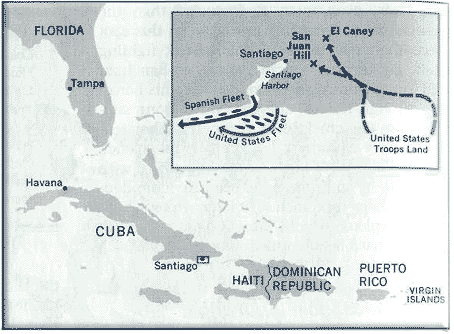Cuban Campaign: An Easy Win in the Spanish-American War
American commanders initially anticipated a lengthy troop training period, but circumstances dictated a change in plans. A Spanish fleet sailed from Europe, causing near panic in the eastern seaboard cities of Boston and New York. In response to the perceived threat, a large portion of the American navy was committed to patrol duties along the North American coast. The Spanish managed to evade the porous American blockade of Cuba and enter Santiago harbor at the southeastern end of the island.

With Spain forcing the issue, the undertrained American soldiers were dispatched from Tampa. The initial aim was to prevent the Spanish forces at Santiago from coordinating actions with the bulk of their existing forces in the west.
General William R. Shafter led the American invasion in areas outside of Santiago in late June. Major military engagements included:
- Las Guásimas—the first land battle of the war in which a larger Spanish force was pushed back toward Santiago
- El Caney—on July 1, American forces captured a small Spanish force in a strategically located stone fortress
- San Juan Heights—a strategic position outside of Santiago from which victorious Americans gained command of the harbor. A sidelight of this battle was the widely reported charge up Kettle Hill, led by Theodore Roosevelt and his Rough Riders. American losses in this fighting were heavy with 280 killed and more than 1,500 wounded.
American leaders were stunned by the casualties at San Juan Hill and fearful of the cost of a direct attack on Santiago. However, they were spared from launching an assault when the commander of the Spanish fleet received orders to break out of the blockaded harbor—a truly suicidal prospect. The two fleets engaged on July 3 outside of Santiago. The Spanish were no match for the superior American navy. They suffered more than 300 killed and 150 wounded. U.S. forces sustained one death and one wounded.
Spanish land forces in Santiago surrendered on July 17. An armistice was signed in August, setting up the framework for a final
peace treaty that was signed in December.
